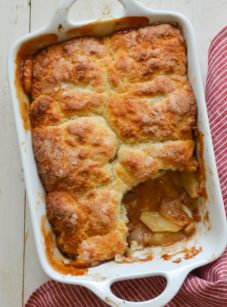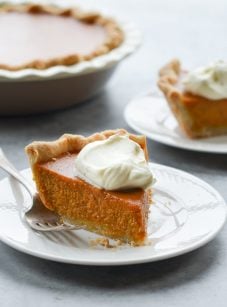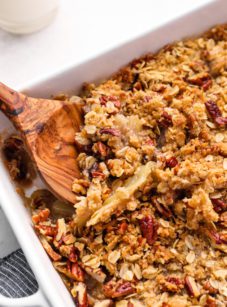Perfect Apple Pie
This post may contain affiliate links. Read my full disclosure policy.
Ready to bake the best apple pie ever? This step-by-step guide will help you create the ultimate pie with a buttery, flaky crust and a gooey, cider-flavored filling—an irresistible fall favorite!

As fall rolls in and apple season reaches its peak, there’s no better time to bake a homemade apple pie—whether you want to use up a bushel of apples or whip up a special Thanksgiving dessert. It may seem daunting, but this tried-and-true recipe makes it easy to bake the perfect pie every time—and it’s so worth the effort!
The secret to making the perfect apple pie is avoiding common pitfalls, like a soupy filling and a soggy crust, by cooking the apples before filling and baking the pie. This simple step thickens the juices, concentrates their flavor, and ensures a crisp, flaky crust with a rich, cider-flavored apple pie filling. This, my friends, is the ultimate pie! Serve it with a scoop of vanilla ice cream, a dollop of whipped cream, or a drizzle of caramel sauce for an extra-special dessert.
“This pie turned out incredible! the crust is delicious and the filling juicy and full of flavor.”
What You’ll Need To Make Apple Pie

- All-Purpose Flour: Provides the essential structure and stability needed for the crust. Additionally, it thickens the filling by absorbing the juices released during baking. Always measure flour by spooning it into the measuring cup and leveling off to ensure accuracy.
- Sugar: Adds a touch of sweetness to the crust.
- Baking Powder: Helps to slightly leaven the crust.
- Butter: Creates flakiness and richness in the crust.
- Ice Cold Water: Binds the dough together. The temperature of the water helps keep the butter cold. This ensures the crust will come out flaky and tender.
- Baking Apples: For apple pie, use baking varietals such as Granny Smith apples, Honeycrisp apples, or Golden Delicious apples (or any combination); they hold their shape when cooked so you don’t end up with applesauce pie!
- Lemon Juice: Prevents the apples from browning and adds a hint of tartness.
- Dark Brown Sugar: Sweetens the filling and adds a rich, molasses-like flavor.
- Ground Cinnamon: Adds warmth and spice to the filling.
- Cornstarch: Works with the flour to thicken the filling, ensuring it isn’t runny.
- Beaten Egg/Cream/Milk: Brushed over the crust to give it a golden, glossy finish. Any of these 3 options will work nicely.
- Granulated or Turbinado Sugar: Sprinkled on top for added sweetness and a slight crunch.
- Jump to the printable recipe for precise measurements
Step-By-Step Instructions
Step 1: Prepare the Crust
Combine the flour, sugar, salt, and baking powder in the bowl of a food processor fitted with the metal blade. Pulse a few times to combine.

Add the pieces of butter and pulse until the mixture is crumbly with lots of pea-size clumps of butter within.

Add the water and pulse until the mixture is evenly moistened and very crumbly.

Dump the dough crumbles onto a work surface and divide into two piles.

Make one pile about 15% bigger than the other. You can eyeball it, but if you have a kitchen scale, one pile should weigh 13 oz (368 g) and the other 11.5 oz (326 g).

Shape into two balls of dough and pat each one into a 5-inch (13-cm) disc. Wrap the discs in plastic wrap and refrigerate for at least 45 minutes or up to 3 days to rest.

Step 2: Prepare the Apple Pie Filling
In a large heavy-bottomed pot or Dutch oven, mix the apples with lemon juice, brown sugar, salt, cinnamon, flour, and cornstarch. Stir until thoroughly combined and both the flour and cornstarch are dissolved.

Place the pot over medium heat and cook, stirring often, until the apples soften and the juices thicken, 11 to 13 minutes.

Transfer the apples and their juices to a baking sheet, spreading them out evenly. Allow them to cool completely.

Preheat the oven to 425°F (220°C) and set an oven rack in the lower third position. Place a baking sheet on this rack to preheat as well. (This acts like a pizza stone, providing a hot surface to help the bottom crust of the pie crisp up effectively.)
Step 3: Prepare the Bottom Crust
Remove the larger disc of dough from the refrigerator. Lightly dust a clean work surface with flour and place the dough on it; sprinkle a bit of flour over the dough as well. Gently knead the dough with your hands just until it becomes soft and malleable (avoid overworking it—you want it just supple enough to roll out). Roll the dough out into a 13-inch (33-cm) circle, adding more flour as needed to prevent sticking.

Carefully lift the dough by draping it over your rolling pin and transfer it to a 9-inch by 1½ -inch (23-cm by 3.75-cm)-deep pie pan, preferably metal (as metal conducts heat more effectively, helping the bottom crust crisp up) but a ceramic or glass pie dish will work too.

Gently press the dough into the pan, making sure to ease it into place without stretching. Trim the edges of the dough to extend about ½ inch (1.25 cm) beyond the pie pan’s lip.

Transfer the cooled apples and their juices into the crust; refrigerate while you prepare the top crust.

Step 4: Prepare the Top Crust
Remove the second disc of dough from the refrigerator and roll it out into an 11-inch (28-cm) circle, following the same process described above. Retrieve the filled pie from the refrigerator and carefully drape the rolled dough over the top.

Crimp the edges with a fork or flute them with your fingers to seal the top and bottom crusts together. Work quickly and dust your fingers with flour as needed to prevent the dough from becoming too warm.

Brush the top crust with egg wash, cream, or milk.

Sprinkle with 2 tablespoons of granulated or turbinado sugar.

Cut four 3-inch (7½-cm) slits in the top crust to allow steam to escape.
Place the pie on the preheated baking sheet and bake at 425°F (220°C) for 15 minutes. Then reduce the oven temperature to 375°F (190°C) and continue baking for an additional 45 minutes, or until the crust is golden brown.

Let the pie cool completely on a wire rack before slicing, at least 4 hours. Resist the temptation to cut into the pie while it’s warm, or you may end up with apple soup!

Video Tutorial
Frequently Asked Questions
Anytime you’re baking with apples whether it’s apple strudel or applesauce, it’s a good idea to use a blend of tart and sweet baking apples for the best flavor. Granny Smith, Honey Crisp, Gala, Jonagold, Jonathan, and Golden Delicious are all good options—try different varietals and see what combinations you like best.
Sure! The pie can be baked up to 1 day ahead of time and stored, loosely covered with foil, at room temperature. If you’d like to reheat it, place the pie on a baking sheet and loosely cover it with foil to protect the crust. Reheat it at 350°F for 15 to 20 minutes, or until it’s warmed through. Just keep in mind that the filling may get a bit soupy when served warm.
Definitely, apple pie can be frozen for up to 3 months before or after baking it. (If freezing it unbaked, hold off on brushing the top crust with the beaten egg and sprinkling it with sugar; you can do that right before baking.) If baked, let it cool completely and place it in the freezer uncovered. When fully frozen, wrap the pie securely in foil and freeze. If the pie is unbaked, wrap it securely in foil and freeze. When ready to serve, proceed with baking instructions above (the pie is likely to take 10 to 15 minutes longer to bake).

You May Also Like
Perfect Apple Pie
Ingredients
For the Crust
- 2¾ cups all-purpose flour, spooned into measuring cup and leveled-off
- 3 tablespoons granulated sugar
- 1 teaspoon salt
- ¼ teaspoon baking powder
- 18 tablespoons (2 sticks + 2 tablespoons) cold unsalted butter, sliced into 1-inch pieces
- 7 tablespoons ice cold water
For the Filling
- 4½ pounds baking apples (about 8 large apples; see note), peeled, cored, and sliced ¼-inch thick
- 1 tablespoon fresh lemon juice, from 1 lemon
- 1 cup (packed) dark brown sugar
- Heaping ¼ teaspoon salt
- Heaping ¼ teaspoon ground cinnamon
- 2 tablespoons all-purpose flour
- 2 tablespoons cornstarch
For Baking
- A beaten egg, heavy cream, or milk, for brushing over crust
- 2 tablespoons granulated or turbinado sugar, for topping the pie
Instructions
Prepare the Crust
- Combine the flour, sugar, salt, and baking powder in the bowl of a food processor fitted with the metal blade. Pulse a few times to combine. Add the pieces of butter and pulse until the mixture is crumbly with lots of pea-size clumps of butter within.
- Add the water and pulse until the mixture is evenly moistened and very crumbly.
- Dump the dough crumbles onto a work surface and divide into two piles, with one pile about 15% bigger than the other. You can eyeball it, but if you have a kitchen scale, one pile should weigh 13 oz (368 g) and the other 11.5 oz (326 g). Shape into two balls of dough and pat each one into a 5-inch (13-cm) disc. Wrap the discs in plastic wrap and refrigerate for at least 45 minutes or up to 3 days to rest.
Cook the Apples
- In a large heavy-bottomed pot or Dutch oven, mix the apples with lemon juice, brown sugar, salt, cinnamon, flour, and cornstarch. Stir until thoroughly combined and both the flour and cornstarch are dissolved. Place the pot over medium heat and cook, stirring often, until the apples soften and the juices thicken, 11 to 13 minutes. Transfer the apples and their juices to a baking sheet, spreading them out evenly. Allow them to cool completely.
Preheat the Oven
- Preheat the oven to 425°F (220°C) and set an oven rack in the lower third position. Place a baking sheet on this rack to preheat as well. (This acts like a pizza stone, providing a hot surface to help the bottom crust of the pie crisp up effectively.)
Assemble & Bake The Pie
- Remove the larger disc of dough from the refrigerator. Lightly dust a clean work surface with flour and place the dough on it; sprinkle a bit of flour over the dough as well. Gently knead the dough with your hands just until it becomes soft and malleable (avoid overworking it—you want it just supple enough to roll out). Roll the dough out into a 13-inch (33-cm) circle, adding more flour as needed to prevent sticking. Carefully lift the dough by draping it over your rolling pin and transfer it to a 9-inch by 1½-inch (23-cm by 3.75-cm) deep pie pan, preferably metal (as metal conducts heat more effectively, helping the bottom crust crisp up) but ceramic or glass will work too. Gently press the dough into the pan, making sure to ease it into place without stretching. Trim the edges of the dough to extend about ½ inch (1.25 cm) beyond the pie pan's lip.
- Transfer the cooled apples and their juices into the crust; refrigerate while you prepare the top crust.
- Remove the second disc of dough from the refrigerator and roll it out into an 11-inch (28-cm) circle, following the same process described above. Retrieve the filled pie from the refrigerator and carefully drape the rolled dough over the top. Crimp the edges with a fork or flute them with your fingers to seal the top and bottom crusts together. Work quickly and dust your fingers with flour as needed to prevent the dough from becoming too warm. Brush the top crust with beaten egg, cream, or milk, and evenly sprinkle with 2 tablespoons of granulated or turbinado sugar. Cut four 3-inch (7.5-cm) slits in the top crust to allow steam to escape.
- Place the pie on the preheated baking sheet and bake at 425°F (220°C) for 15 minutes. Then reduce the oven temperature to 375°F (190°C) and continue baking for an additional 45 minutes, or until the crust is golden brown. Let the pie cool completely on a wire rack before slicing, at least 4 hours. Resist the temptation to cut into the pie while it’s warm, or you may end up with apple soup!
Notes
Nutrition Information
This website is written and produced for informational purposes only. I am not a certified nutritionist and the nutritional data on this site has not been evaluated or approved by a nutritionist or the Food and Drug Administration. Nutritional information is offered as a courtesy and should not be construed as a guarantee. The data is calculated through an online nutritional calculator, Edamam.com. Although I do my best to provide accurate nutritional information, these figures should be considered estimates only. Varying factors such as product types or brands purchased, natural fluctuations in fresh produce, and the way ingredients are processed change the effective nutritional information in any given recipe. Furthermore, different online calculators provide different results depending on their own nutrition fact sources and algorithms. To obtain the most accurate nutritional information in a given recipe, you should calculate the nutritional information with the actual ingredients used in your recipe, using your preferred nutrition calculator.






I made a practice pie for Thanksgiving and it was soooo delicious! My question is, would it be ok to let the apples and sugar mixture sit overnight as I need to get things done the night before? Can I tell you again how much I loved this pie? 🙂
Hi Caryn, The only thing I worry about is the apples browning but I think they will be okay with the sugar and lemon juice. You can also bake the whole pie a day ahead, if you like. Hope that helps!
I have made dozens of apple pies and this recipe is hands-down THE BEST! It takes longer to make than any other apple pie I’ve made. Reducing the juices really makes this pie – I hate cutting into a pie and finding it is ‘runny’. So if you want a foolproof recipe that truly delivers a spectacular dessert, you’ve found it here!
I have a gadget that you place over the rolled crust to make it into a lattice top. Would this work on this recipe? Would it change cooking time or results?
Hi Gayle, I’m not familiar with the tool, but I suspect it should work. The baking requirements will be the same. I’d love to hear how it turns out if you try it!
Could this pie be made with a crumb/crumble topping instead of a top crust? If so, which crumb recipe do you recommend?
Yes, Jane, I think the topping that goes on my Apple Pecan Crisp would work very nicely here. I’d love to hear how it turns out if you try it this way!
I would like to make the filling without the pie crust. What would you recommend I do for stove top cooking?
Hi Karen, I’d follow the instructions from this apple french toast recipe for sauteeing the apples. 🙂
Whenever I use one of your recipes Jenn, I am confident that I will not be disappointed. This apple pie was well worth the extra effort it took to make it. As with anything, a little hard work results into something you can be proud of. You should be proud Jenn and thank you for all the research you do with each recipe you share with us. I followed your recipe exactly and was rewarded with the best apple pie my family has ever had!!!
Too time consuming. Followed recipe and pie crust still cracked and was destroyed after putti g ot un the oven…
Maybe it’s just me but after spending so much time and effort and dirtying all the dishes it is a little defeating for the whole thing to not work out.
Maybe baking just isnt for me.
First time I tried to make an apple pie and I was amazed at the results. Sweet, cripsy, and smells amazing. And not too difficult either. I used one large honey crisp, two medium NY snowsweet, and four small macoumb.
I made this pie with Granny Smith apples and easily three times the cinnamon and it was absolutely THE best apple pie I’ve ever made.
We had a few kids from Rocky Mountain college football team coming over and I wanted them to have some real home cooked food.
I blinked and it was gone!
Seriously, the most delicious and perfect from crust to crust. Thank you for elevating my game!
I love this recipe. Pie crust made easy. Thank you!!